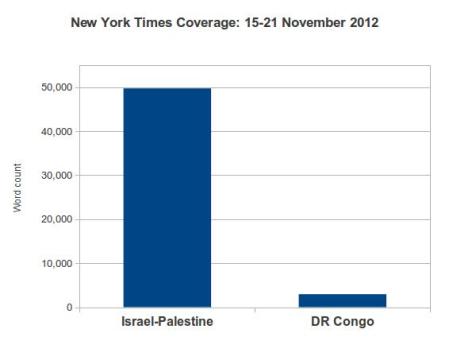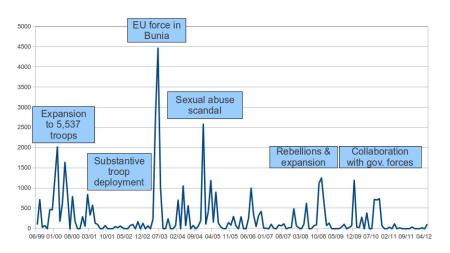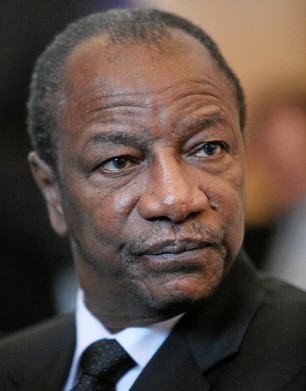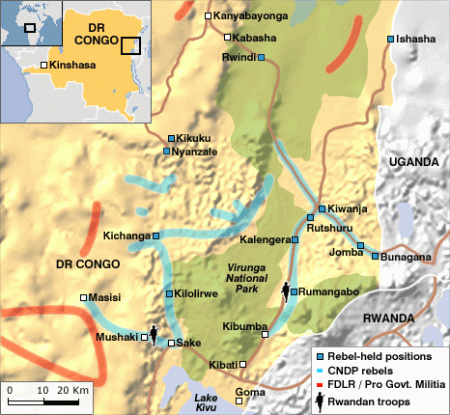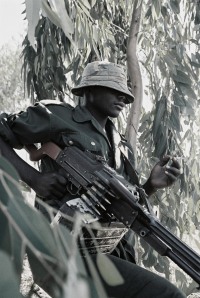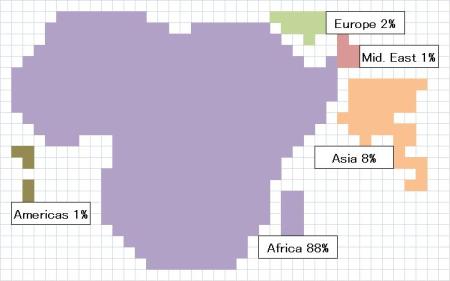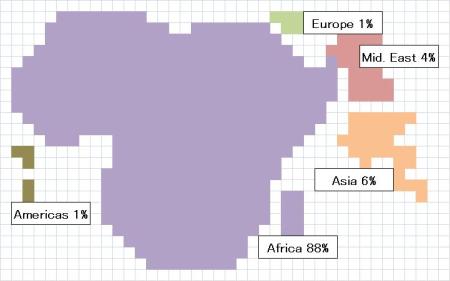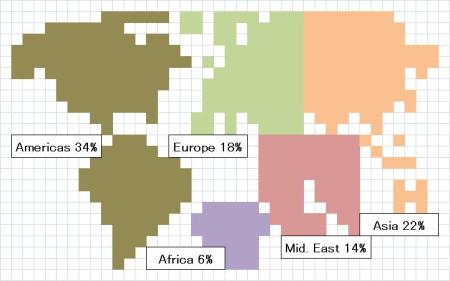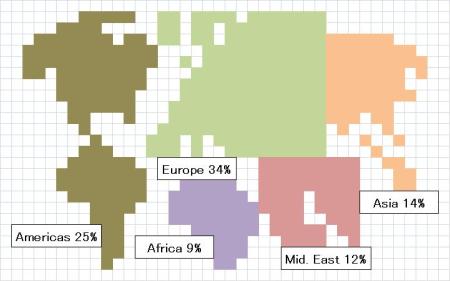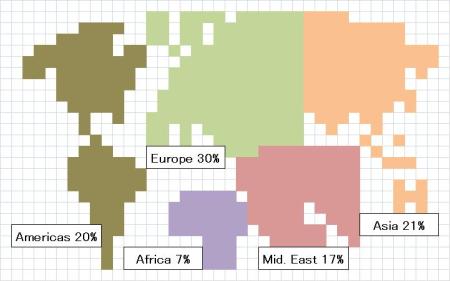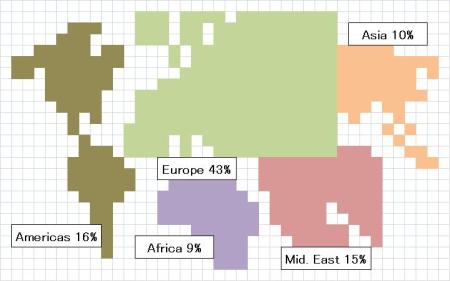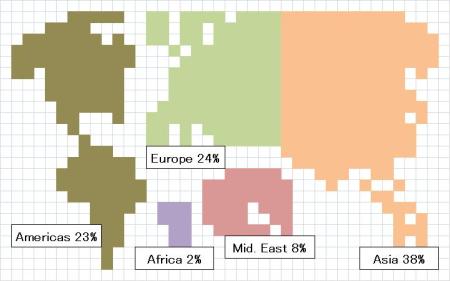The media barrage on the conflict in Israel-Palestine is unrelenting. Consumers of media products around the world continue to be subjected to article after article, front-page headline after front-page headline, hour after hour of coverage on this conflict, all demanding our attention. At times it seems not only that the world at this point revolves around Israel-Palestine, but almost as if Israel-Palestine is the only place in the world (apart from the country we happen to live in) worthy of our attention at all.
This is what a ‘chosen’ conflict looks like. It is admittedly not as chosen as some conflicts, like Iraq in 2003, or Afghanistan in 2001, or Kosovo in 1999. For a conflict to be chosen in this way – to the point that coverage of that conflict seriously interrupts regular programming – generally requires that US troops are directly involved, bombing or invading the country in question. When Iraq was invaded, the 24-hour news channels ended up casting to the wind whatever was happening in the rest of world at the time (like the overthrow of the democratically elected government in the Central African Republic), broadcasting instead hour after hour of live footage (from embedded journalists) of tanks in Iraq doing little more than driving north.
So this conflict is not quite that chosen, but it does dominate the news wherever you turn. A look at the main homepage for the New York Times website on January 11, for example, revealed 10 links to different articles on the conflict, including ‘Multimedia on Gaza’ (interactive graphics), a timeline of Israel, the Gaza Strip and Hamas, and a video analysis of the Gaza conflict. And that is just the main homepage. Click on the Middle East page and a multitude of additional articles reveal themselves, along with links to blogs on the conflict.
On the BBC homepage on the same day, a click on the Middle East link will lead you to a choice of 28 items on the Israel-Palestine conflict, including feature articles on ‘Lost innocents’ and ‘Gaza aid’, Mideast papers on Gaza, a Gaza conflict map, and ‘Rallies for Gaza’ in pictures. On the CNN homepage, there were more than 150 videos posted on the conflict in just two weeks (since 24 December 2008). In Japan, the editorial for the Asahi Shimbun (newspaper) for 8 January was titled ‘The Gaza tragedy: for how long will we leave it be?’
All this saturation coverage appears to have had a significant impact on the general public. The internet is buzzing with copious quantities of all manner of comment and chatter, and thousands have gone out onto the streets, from London to Indonesia (and even to Osaka) to demonstrate about the situation. Both sides are highly emotionally charged, with the majority seeming to be outraged by the high loss of innocent life (primarily on the Palestinian side), and others (much fewer in number) insistent that the Palestinians brought it on themselves, and that Israel should have the right to defend itself. What needs to be noted is that, regardless of which side they take, there are so many people talking about the conflict. As Bernard Cohen famously said, the press “may not be successful much of the time in telling people what to think, but it is stunningly successful in telling its readers what to think about”.
Whether it is the media obsessing over the conflict or the members of the public lending their voices to the issue, the tone of so much of the discussion is of the humanitarian variety. There is so much concern about the loss of innocent life. Words like ‘horror’, ‘tragedy’, ‘carnage’ and ‘humanitarian crisis’ are being used in abundance, and the media corporations present the humanitarian toll in great detail, finding individuals with harrowing stories to tell, and helping us to know them and feel their pain. Variants of the phrase ‘we cannot stand by and watch this happen’ (or ‘the world cannot stand by’, or ‘the international community cannot stand by’ – whatever ‘the international community’ is supposed to mean) are also being used in abundance.
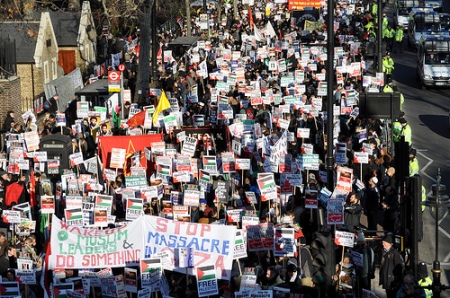
Outpouring of public outrage and sympathy in London (Photo: Mattsays)
But the sad reality is that that is exactly what we tend to do. We do stand by and do nothing about the vast majority of conflict-related suffering in the world. We are perfectly capable of ignoring humanitarian suffering in most of the world’s conflicts most of the time. This is to a large degree unavoidable – there is so much conflict-related humanitarian suffering that we have to be selective. There are 20 or 30 conflicts ongoing in varying degrees in the world at any point in time (depending on one’s definition of conflict).
But almost all of the deadliest conflicts in the world are happening in Africa (with the exception of Iraq and Afghanistan), and it is these conflicts that we ignore the most. Roughly 500 people (estimates seem to have increased) were killed in a series of Christmas massacres in the Democratic Republic of Congo (DRC) after a multinational offensive against the Ugandan LRA. But there has been no outpouring of sympathy or outrage (or of anything except apathy) for these people and their families, and what has happened in the course of the offensive since then may as well be altogether unknown. The New York Times has shed no ink at all for the conflict since it reported on the Christmas massacres in a single article, sparing just 748 words for the conflict since mid-December. Compare that to the 44,480 words it lavished on Israel-Palestine in just two weeks after fighting began to intensify. And compare CNN’s 150 videos on Israel-Palestine on their website in the same two weeks to the zero videos on the offensive against the LRA. The lack of any semblance of proportionality is staggering.
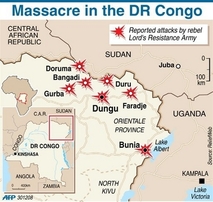
Why are we so absorbed with the humanitarian consequences of conflict in one particular case (Israel-Palestine), that we have not a drop of sympathy remaining for all the rest – especially those that are much worse? There is no stopping to even question why this conflict is so much more important than the others, why others should be erased from the possible media agenda altogether (if they were ever there to begin with). Why have all the media corporations and the general public all jumped on the same humanitarian bandwagon?
However we choose to justify the exclusive saturation coverage of Israel-Palestine, we run into some inescapable contradictions. If it is about humanitarianism, why are those in Israel-Palestine more ‘human’ than others – why is far greater human suffering elsewhere almost completely ignored? If it is about religion, why is the persecution of people based on faith elsewhere given so little attention? If it is about the effect of the conflict on the price of oil, why don’t we care about conflict in the Niger Delta region of Nigeria (a major player in the oil business), where conflict is directly responsible for a reduction of one-quarter of its oil exports? If it is about terrorism, why does the terrorism practiced by warlords in any other of the world’s conflicts go unnoticed?
None of these reasons seem to hold up. About the only excuses that seem to remain are that the politicians are all talking about it (and they always have), our reporters are on the scene anyway, and the other media corporations seem to believe so much in its importance (follow-the-leader and pack journalism). The ‘important’ players in world affairs believe it is important, and therefore it must be. And because they have believed it is so important for so many years, then the whole process becomes self-sustaining and automatic.
But with the levels of disproportion in attention so extreme, the question begs to be asked: how does this situation go unchallenged? Are the victims of conflict in the DRC not human enough to qualify for our ‘humanitarian’ concern? Or is it because the media’s high-beam spotlight on the Israel-Palestine conflict is so intense and its blackout over the conflict in the DRC so dark? And why are we the public just going along with it, swallowing whole what we are fed? Is it a case of out of sight, out of mind? Is it that the conflict in the DRC doesn’t bother us because the newspapers and TV stations are not constantly waving it in our face?
Whatever the reasons, it is clear that so much of the world is suffering from an acute case of selective indignation, and worse still, no one even seems to notice…
